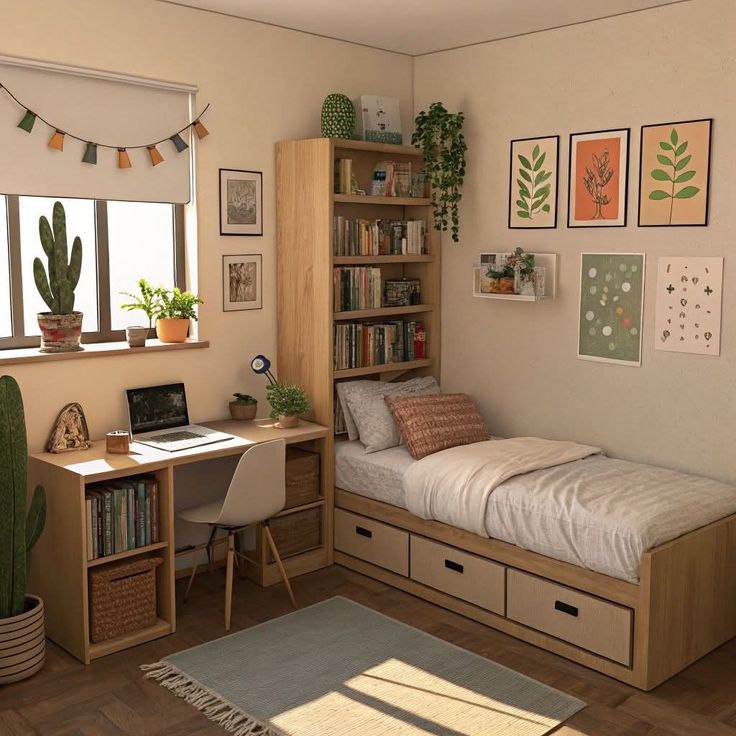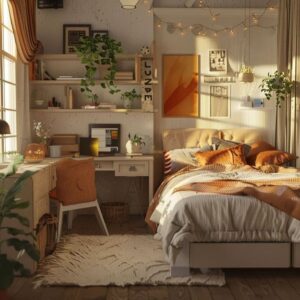
Kavindya Senevirathna
Transforming Your Bedroom into a Sanctuary: Simple Steps for Peace, Comfort, and Better Sleep


Our lives today are fast-paced, chaotic, and stressful. Between the hustle and bustle of work, school, and the constant demands of the internet, it can be difficult to find the time or space to relax our minds. In times like these, the bedroom becomes a vital place to help our minds unwind. A well-organized, simple, and thoughtfully arranged bedroom can have a positive impact on our mental health, sleep quality, and long-term happiness.
Organizing your bedroom to help you relax can be achieved in a few simple steps. A cluttered room can disrupt our thoughts and emotions. Therefore, removing unnecessary items, arranging your belongings, and creating a peaceful environment are all essential steps you can take to promote relaxation.
In this article, we will explain all three of these processes and provide tips on how to organize your bedroom to make it a calm, restful, and healthy environment. By following these methods, your bedroom can become a planned, comfortable, and peaceful place, providing your mind with the essential conditions for quality sleep and emotional balance.
Getting Rid of Unnecessary Things: The First Step to Peace of Mind
When organizing your bedroom, it is important to first get rid of unnecessary items. If our room is full of clutter, it directly affects our mental state. A cluttered bedroom can negatively impact our mood, ability to sleep, and overall sense of peace. Therefore, going through all the items in the room and discarding things that have not been used for a long time, are no longer needed, or are no longer useful to you is the first crucial step to organizing your bedroom.
To begin this process, first divide your room into categories. For example, it is advisable to sort things such as clothes, books, papers, and appliances. By going through each category, you can easily identify items that are unused, unnecessary, or forgotten over time. Then, items should be sorted into three categories: things that can be used, things that can be donated, and things that need to be thrown away. This classification makes it easier to organize the room and arrange belongings when you put them back in place.
When getting rid of things that you don’t need, ask yourself, “Will I use this today, tomorrow, or in the near future?” and “Does this item really serve a purpose, or has it been unused for a long time?” This process will help reduce stress and clutter while freeing up space in your room.
If the items you are discarding are still usable, you can sell them online or donate them to someone who can make use of them. Donate items to reputable institutions or individuals who need them, such as books, clothing, or electronics. If something needs to be thrown away, dispose of it responsibly to keep the room clean and reduce harm to the environment.
By completing this process, your bedroom will become a small, orderly space, and your mind will feel calm, peaceful, and ready for restful sleep. Decluttering your bedroom is the first step toward organizing it properly, which is fundamental to achieving peace of mind and long-term happiness.
Cupboard and Design: Planning for Simplicity and Comfort
The second important step in organizing a bedroom is planning the cupboard and overall room layout carefully. Keeping every item in the room, such as the bed, cabinets, chairs, and other equipment, in an optimal position gives the room a sense of simplicity and comfort. Arranging the bedroom in a simple, orderly, and functional way also provides peace of mind and relief from stress.
When planning the cupboard, first consider the placement of the main items in the room. For example, placing the bed near a wall rather than in the center of the room will increase usable space. This arrangement facilitates movement and ensures that the room remains uncluttered. Additionally, after positioning the bed, design a bedside table so that essential items (electronic devices, books, or small personal belongings) are easily accessible.
Using drawers, shelves, and organizers will help keep items in order and reduce clutter. Accessories like drawer organizers, shelf dividers, and under-bed storage containers allow you to store belongings in a simple, organized way. This makes it easier to find what you need and ensures the room remains neat and orderly.
Another crucial aspect of properly organizing a room is minimizing unnecessary space usage. By reducing non-essential items, small appliances, or excessive decor, the room appears simple and clean. This has a direct positive effect on your mental state. A simple and organized room relaxes the mind, creating an environment conducive to relaxation and sleep.
Properly planning the room layout and cupboard arrangement increases the usability and comfort of the space. With a well-thought-out design, the room becomes clear, simple, and stress-free. This step is foundational for calming the mind, promoting long-term happiness, and improving sleep quality.
Creating a Peaceful Environment: Colors, Light, and Personal Touches
The third essential step in organizing a bedroom is designing the environment to be peaceful and relaxing. Colors, lighting, and personal touches in the room have a direct impact on the mind. A properly arranged room provides peace of mind, promotes restful sleep, and contributes to long-term happiness.
First, the choice of colors is extremely important. Using the right colors in the bedroom can instill a sense of calm, relaxation, and tranquility. Soft and calming colors, such as blue, white, pale pink, or pastel shades, enhance the sense of clarity and openness in the room. Maintaining color consistency across walls, bed linens, and small decorative items gives the room a cohesive and simple appearance. These colors have a calming effect, reducing stress and mental clutter.
Second, lighting plays a significant role in influencing mood. Soft, soothing lighting creates a peaceful atmosphere conducive to sleep. Instead of relying solely on overhead lights, incorporate bedside lamps, fairy lights, or soft LED lights to provide a gentle, warm glow. Designing lighting to avoid harsh or overly bright sources fosters a comfortable and relaxing environment for the mind.
Third, adding personal touches through decor directly affects emotional well-being. Including items such as photos, books, small pieces of art, or travel memorabilia that evoke positive memories can enhance relaxation and sleep quality. Personal mementos create a comforting and stress-free environment, making the room feel uniquely yours.
Finally, combining thoughtful color choices, gentle lighting, and personal touches transforms the bedroom into a peaceful, organized space with a direct positive impact on mental health. These steps ensure that your bedroom is simple, comfortable, and conducive to long-term happiness and restful sleep.
The bedroom is an essential environment for calming the mind and promoting well-being. Removing unnecessary items, organizing furniture and storage, and creating a peaceful atmosphere through color, light, and personal touches transforms the room into a simple, orderly, and comfortable sanctuary. In the process, the ability of the mind to relax and achieve restorative sleep is significantly enhanced.
Creating a simple, organized, and stress-free bedroom has lasting positive effects on mental health. A well-organized room reduces the chaos and stress of daily life, promotes peace of mind, and provides the rest necessary for a balanced lifestyle.
Therefore, making our bedroom a clear, simple, and comfortable environment is a vital step toward calming the mind and fostering emotional well-being. Even though it is a small space within the home, organizing it correctly can greatly reduce daily stress and cultivate long-term happiness and serenity.